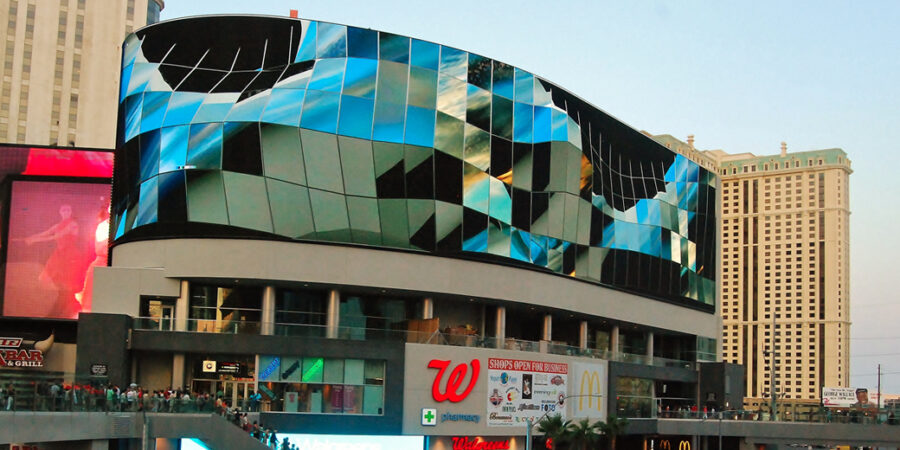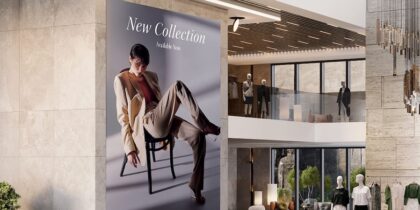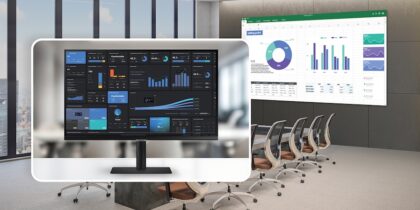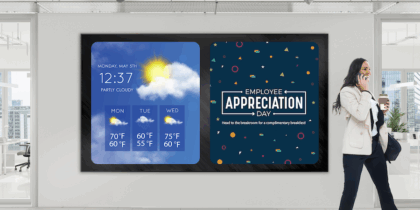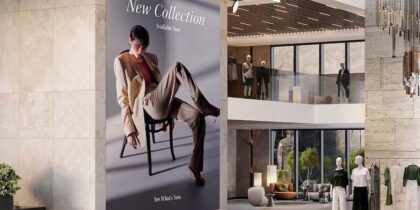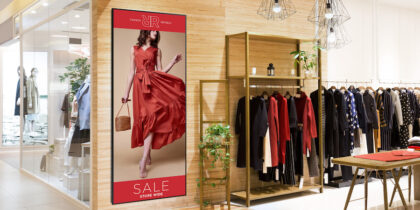LED displays are no longer out of reach for most businesses. The cost of LED business signage is declining, and several factors are driving the prices down, including rapidly evolving product lines, fluctuating market conditions and increased efficiency in the tech and manufacturing sectors.
“When you look back at the last several years, 100,000 became 70,000, and 70,000 became 40,000,” says Ben Sewell, a sales manager in Samsung’s Display Division. “I’d estimate LED display prices have dropped by 50 percent in the last four or five years.”
This is good news for buyers looking to invest in an LED display. If you’re considering an LED display, here are the factors will contribute to the cost — and what you need to know about pricing.
A closer look at LED display costs
“‘Who’s responsible for electrical?’ I get that question every time,” says Sewell. When it comes to LED display projects, many buyers don’t understand all of the costs the project demands beyond the display itself. And there are many — starting with construction.
“Construction is actually the biggest variable,” says Sewell. “You’ve got installation, labor, materials, equipment, steel, electrical, data, permitting and so on. If you’re looking at a million-dollar project, it’s not uncommon that $500,000 would be the tech and the other half would be the install piece.”
How to plan and deploy direct view LED signage
Everything you need to know about choosing your LED displays for optimal viewing indoors and out. Download Now
As many contractors will tell you, buyers often get swept up in the front-end visuals and don’t look closely enough at the back-end costs. A consequential factor many buyers aren’t aware of is display weight. It can have a tremendous impact on the final price of an LED project.
“We try to stick to around 10 pounds per square foot in terms of weight of display,” says Sewell. “If you’re on a 1,000-square-foot display, the difference between 10 pounds and 14 pounds is tremendous — it’s a huge component cost. You’re investing a huge percentage of your budget into the back end. We try to stay on the lighter side, so we have less of those costs.”
Everybody who purchases an LED display for their business knows they’ll need content. But often they don’t consider how significantly it will affect the overall cost of the control system. “The content management system [CMS] could easily be 20 to 25 percent of the project,” says Sewell. “Think of it as the brains behind the content. For example, you might spend $150,000 to $250,000 to cover your control room — and the content. Think of that as the brains.”
Obviously, maintenance is a cost — but not as significant a cost as you might expect. “In many cases, maintenance is not a major part of the expense,” says Sewell. “Here and there, you may need to change filters, let’s say. But typically you’re changing out components that are often under warranty.”
But even warranty is something that bears close examination. “Lots of our competitors just generically talk about their warranty,” says Sewell. “They might say they offer a seven-year warranty. But then later, you find out it’s just for parts. So, every time the owner needs to switch out a module, they have to pay for the lift, the contractor and so on.”
Samsung’s standard warranty is three years’ parts for indoor LED and two years’ parts for outdoor LED, with flexibility to add additional years of parts and labor. We designed it this way to tailor our proposed solution to each project and balance the customer’s budget and goals.
How to price out an LED project
So how does an LED display project get priced? After an initial discussion on configuration — how tall, how wide and so forth — copious attention is placed on the scope of work and exactly what that entails.
“The best thing to do is to have really clear scopes of work, and a clear delineation of work,” says Swell. “That saves everybody money.”
The gaps are where things get a little gray, he explains. When it’s unclear which vendor is handling which aspect of the project, it invites scope creep. Unscrupulous vendors will take advantage of that — “oh, we didn’t know you wanted to include all the electrical” — and by the time that arises, you’re too deep into the project to easily back out.
That’s why it’s best to know who is responsible for every aspect of the project, far beyond the display itself: electrical, data, steel, concrete, permitting and so on. To simplify this process, Samsung can take a turnkey approach, where everything is included — and we handle the demarcation of work within our network of proven suppliers.
“Our approach is direct, transparent and upfront about what we’re doing, why and how we’re doing it,” says Sewell. “We won’t be the lowest bid — but we’ll be the clearest bid.”
And when it comes to evaluating vendors, don’t rely on brand names or surface-level credentials. Dig into actual project examples. “Ask them to give you some drawings, to walk you through some previous projects they’ve worked on,” says Sewell. “You want to understand how they work — everybody is different. How we approach projects at Samsung is different from others, so you need to dig into those details.”
Taking the next step
Components, size, resolution, maintenance, content — much of the LED display pricing process is about manipulating these and all the other LED display factors until your project falls in line with your budget. “We pull and push those levers all the time,” says Sewell. “That’s at the heart of our sales approach — we try to be as consultative and interactive as possible, working with designers and architects to coordinate everything. The earlier on we can be there, the more pitfalls we can avoid.”
If you’re looking to invest in an LED display, now’s the time. In response to marketplace turbulence, many manufacturers are offering significant discounts and are open to negotiating on many variables influencing a project. “It’s a good time to want to buy an LED display,” says Sewell. “People are looking to be aggressive, and if you’ve got the cash to spend, now is the time to spend it — you can get a great deal.”
For more tips on configuring and tailoring on-screen messaging in real time, get your free comprehensive guide to using an integrated CMS. And for an array of innovative display options, discover Samsung’s full lineup of LED signage — which provide versatile solutions for diverse business needs.
